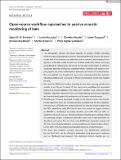Files in this item
Open-source workflow approaches to passive acoustic monitoring of bats
Item metadata
| dc.contributor.author | Brinkløv, Signe M. M. | |
| dc.contributor.author | Macaulay, Jamie | |
| dc.contributor.author | Bergler, Christian | |
| dc.contributor.author | Tougaard, Jakob | |
| dc.contributor.author | Beedholm, Kristian | |
| dc.contributor.author | Elmeros, Morten | |
| dc.contributor.author | Madsen, Peter Teglberg | |
| dc.date.accessioned | 2023-05-26T11:30:05Z | |
| dc.date.available | 2023-05-26T11:30:05Z | |
| dc.date.issued | 2023-07-01 | |
| dc.identifier | 286647332 | |
| dc.identifier | af304c52-246e-4ec8-a907-8c70a29fe17d | |
| dc.identifier | 85159953504 | |
| dc.identifier.citation | Brinkløv , S M M , Macaulay , J , Bergler , C , Tougaard , J , Beedholm , K , Elmeros , M & Madsen , P T 2023 , ' Open-source workflow approaches to passive acoustic monitoring of bats ' , Methods in Ecology and Evolution , vol. 14 , no. 7 , pp. 1747-1763 . https://doi.org/10.1111/2041-210X.14131 | en |
| dc.identifier.issn | 2041-210X | |
| dc.identifier.other | RIS: urn:D4438D919E4AAEA9495A42DA920C78D2 | |
| dc.identifier.uri | https://hdl.handle.net/10023/27683 | |
| dc.description | Funding: The work was funded by grants to PTM from Carlsberg Semper Ardens Research Projects and the Independent Research Fund Denmark. | en |
| dc.description.abstract | The affordability, storage and power capacity of compact modern recording hardware have evolved passive acoustic monitoring (PAM) of animals and soundscapes into a non-invasive, cost-effective tool for research and ecological management particularly useful for bats and toothed whales that orient and forage using ultrasonic echolocation. The use of PAM at large scales hinges on effective automated detectors and species classifiers which, combined with distance sampling approaches, have enabled species abundance estimation of toothed whales. But standardized, user-friendly and open access automated detection and classification workflows are in demand for this key conservation metric to be realized for bats. We used the PAMGuard toolbox including its new deep learning classification module to test the performance of four open-source workflows for automated analyses of acoustic datasets from bats. Each workflow used a different initial detection algorithm followed by the same deep learning classification algorithm and was evaluated against the performance of an expert manual analyst. Workflow performance depended strongly on the signal-to-noise ratio and detection algorithm used: the full deep learning workflow had the best classification accuracy (≤67%) but was computationally too slow for practical large-scale bat PAM. Workflows using PAMGuard's detection module or triggers onboard an SM4BAT or AudioMoth accurately classified up to 47%, 59% and 34%, respectively, of calls to species. Not all workflows included noise sampling critical to estimating changes in detection probability over time, a vital parameter for abundance estimation. The workflow using PAMGuard's detection module was 40 times faster than the full deep learning workflow and missed as few calls (recall for both ~0.6), thus balancing computational speed and performance. We show that complete acoustic detection and classification workflows for bat PAM data can be efficiently automated using open-source software such as PAMGuard and exemplify how detection choices, whether pre- or post-deployment, hardware or software-driven, affect the performance of deep learning classification and the downstream ecological information that can be extracted from acoustic recordings. In particular, understanding and quantifying detection/classification accuracy and the probability of detection are key to avoid introducing biases that may ultimately affect the quality of data for ecological management. | |
| dc.format.extent | 17 | |
| dc.format.extent | 11866887 | |
| dc.language.iso | eng | |
| dc.relation.ispartof | Methods in Ecology and Evolution | en |
| dc.subject | Automated | en |
| dc.subject | Bat | en |
| dc.subject | Classification | en |
| dc.subject | Deep learning | en |
| dc.subject | Detection | en |
| dc.subject | Echolocation | en |
| dc.subject | Open source | en |
| dc.subject | Passive acoustic monitoring | en |
| dc.subject | DAS | en |
| dc.subject | MCC | en |
| dc.title | Open-source workflow approaches to passive acoustic monitoring of bats | en |
| dc.type | Journal article | en |
| dc.contributor.institution | University of St Andrews. School of Biology | en |
| dc.identifier.doi | 10.1111/2041-210X.14131 | |
| dc.description.status | Peer reviewed | en |
This item appears in the following Collection(s)
Items in the St Andrews Research Repository are protected by copyright, with all rights reserved, unless otherwise indicated.

